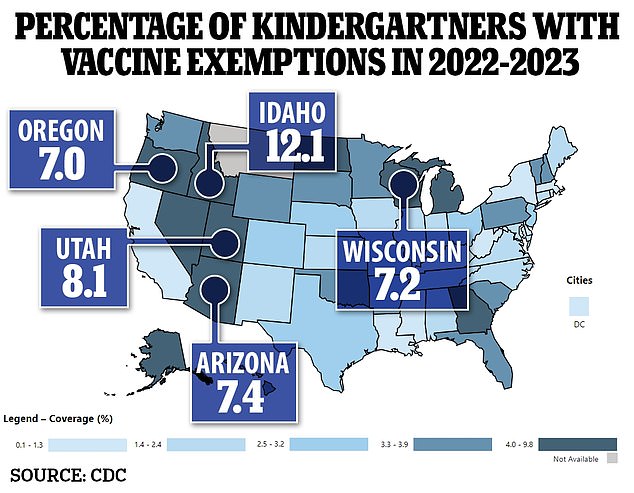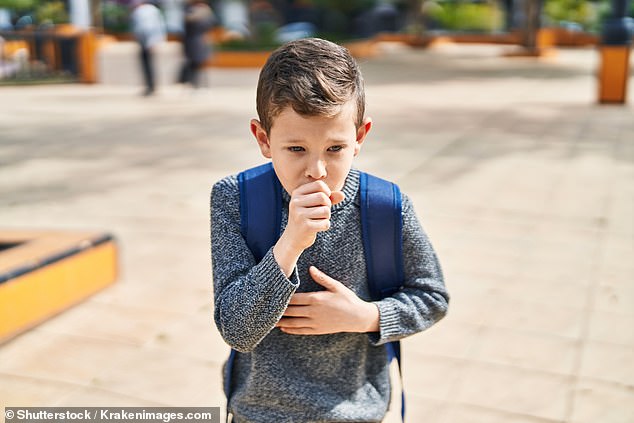Idaho health officials have issued a warning about a sharp rise in cases of a highly contagious Victorian-era disease.
Two public health organizations have joined forces to warn citizens of the State of Gem that cases of whooping cough, better known as pertussis, are 17 times higher this year than last year.
So far, 171 cases have been recorded, most of which have occurred in children, who are particularly susceptible to the disease.
It can cause “violent coughing fits” that last for months, as well as fever, shortness of breath and congestion.
The disease, which was common in the 1900s, had previously been controlled by vaccination, but Idaho has emerged as the state with the lowest uptake of all recommended vaccines in the U.S. in recent years.
Whooping cough is transmitted from person to person through droplets in the air when coughing or sneezing. Once in the body, the bacteria multiply and release toxins into the respiratory system that cause tissues to swell, leading to the cough characteristic of the disease.
Lekshmi Venugopal, an epidemiologist with the Southwest Idaho Health District, said, “We are deeply concerned about the significant increase in whooping cough cases in southwest Idaho this year.”
In the entire year of 2023, there were only 10 cases in the state, representing a 1,600 percent increase in cases. This was reported by the Idaho Statesman newspaper.
So far, 117 cases have been reported in Ada County, in the southwestern part of the state, which includes its capital, Boise.
Canyon County, directly west of Ada, reported 49 cases.
About 67 percent of these cases occurred in people under the age of 19.
‘Whooping cough, although it may start like a common cold, can cause long-term illness and serious complications, especially in infants and people with pre-existing health problems,’ Dr. Venugopal said.
Whooping cough is a bacterial infection that is transmitted from person to person through the air via respiratory droplets.
Symptoms appear about a week after the initial infection, after the bacteria attach to tiny hairs in the throat and nose and begin releasing toxins that cause the airways to swell. According to the Centers for Disease Control and Prevention.
At first, this causes a runny or stuffy nose, low fever, and mild cough, but it can progress to violent coughing fits that result in vomiting, exhaustion, and trouble breathing.
“People who have these coughing fits say it is the worst cough of their lives,” the CDC website details.
About one percent of babies who contract the disease die.
The disease can be prevented (by vaccination) and treated (by antibiotics).
However, Idaho typically has among the lowest childhood vaccination rates in the country.
In the 2022-2023 school year, about 81 percent of Idaho’s kindergartners met federal public school vaccination requirements, the lowest percentage in the country, where the average rate is 93 percent.

The map above shows vaccination exemption rates by state for the 2022-2023 school year, highlighting the top five states with the highest percentages of exemptions for all required school vaccines.
The state also has the highest percentage of kindergartners requesting vaccine exemptions, about 12 percent, compared to the national average of 3 percent.
Public health authorities constantly promote vaccination, which they claim dramatically reduces whooping cough rates. These vaccines protect about 98 percent of children in the year following the last dose. According to the Centers for Disease Control and Prevention.
In the 1900s, whooping cough was one of the most common childhood diseases; before the vaccine became widely available in the 1940s, the number of cases had increased. decreased by more than 90 percent.
U.S. health officials recommend that everyone receive two doses of the COVID-19 vaccine to protect against the disease: one dose of DTaP in childhood and one dose of Tdap around age 11.


